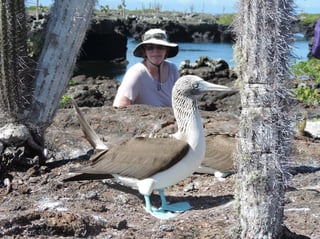 The Galapagos is the ultimate vacation destination for wildlife and nature loving families. Not only does this experience bring to life lessons learned in the classroom, it allows for up close and intimate experiences with creature great and small.
The Galapagos is the ultimate vacation destination for wildlife and nature loving families. Not only does this experience bring to life lessons learned in the classroom, it allows for up close and intimate experiences with creature great and small.
The Galapagos consist of about 20 pacific islands that straddle the equator and lie about 600 miles west of Ecuador in South America. Only 5 islands are inhabited with a total population of around 25,000 people. The government of Ecuador has designated 97% of the land area in the Galapagos Islands as a national park along with very strict rules protecting it's flora and fauna. The remaining 3% of non park land is distributed between the inhabited areas of Santa Cruz, San Cristobal, Floreana and Isabela islands.
The Galapagos is a geologic hot spot of volcanic islands. Some older islands have disappeared by newer islands like Isabela and Fernandina are still forming. The Galapagos islands served as inspiration for Charles Darwin's theory of evolution and his 1859 book the Origin of the Species.
One of the most amazing features of the Galapagos islands is the lack of natural predators. This, along with strict government controls of this UNESCO world heritage area result in a wild life population that has little to no fear of humans. Park rangers insist that visitors stay at least 6 feet away from any animals. That of course doesn't stop sea lions from hopping up and sitting next to you on a park bench or marine turtles from swimming up next to you in a lagoon.
To get the most out of your family's travels to the Galapagos you really should work with an experienced travel agent who knows out to connect you with the best guides and outfitters based on your family's needs and desires.
If you're considering a visit to the Galapagos for your next family adventure, here are some tips and FAQ to help get you started in the right direction...
How do we get there? - Seymour airport on Baltra Island is the main airport of the Galapagos Islands where most tourists arrive. Basically the only thing on Baltra island is the airport. Flights to Baltra Island connect from the Ecuadorian mainland from either Quito or Guayaquil airports and generally cost between $400-$500 for the 1.5 to 3 hour flight depending on your departure point.
When checking in at either airport in mainland Ecuador, all visitors will be required to have your bags inspected by the Galapagos Biosecurity Agency quarantine staff and obtain a mandatory $20 tourist transit card. Upon arrival at Baltra airport in the Galapagos, you will have to pay an entrance fee in cash to the Galapagos National Park (currently the fee is $100 for non-Ecuadorian adults and $50 for children).
Quayaquil airport is pretty much at sea level. The reason I mention this is because Quito is high in the Andes Mountains at approximately 9000 feet. Travelers often worry about altitude sickness visiting Machu Picchu, which by comparison is around 8000 feet. I mention this because if anyone in your family suffers from breathing conditions like asthma, COPD or other such ailments, you may want to consider your choice of arrival airports in Ecuador.
What's the Best Age to Visit with Kids? - In my professional opinion after visiting myself, I suggest the Galapagos as an ideal destination for families with kids ages 10 and up. It is ideal for tweens and teens. Parents should bear in mind that kids will need the patience for flights with connections, be able to hike rocky terrain and be a strong swimmer. Some of the most astonishing sights of the Galapagos are under water so to appreciate this I would suggest your kids be fairly skilled snorkelers at the very least.
Most guided tour companies like Gadventures or Adventures by Disney have age requirements for their tours. Each tour company differs but the minimum age is between 6-12 years of age before they are allowed on a tour. The reason they have these rules is to protect the enjoyment, safety and investment of ALL passengers.
The Galapagos is an ideal destination for small family multi-generational groups. Often families will hire their own boat or a private tour guide. If an entire family books their own small group tour then child age requirements do not apply. Again each tour company has their own definition of the number of passengers required for a private tour but generally the number is around 12 people or more.
Should we go by land or by sea? Most tourists sea the Galapagos islands by sea. Boats range from 12–100 passengers and are divided into four categories of service: economy, tourist, first class, and luxury. Due to the strict protection rules of the National park, ships larger than 100 passengers are not allowed in the island waters. The advantage of cruising the Galapagos is that your ship will be traveling at night while you're asleep. There is no need for packing and unpacking. You'll arrive refreshed and ready to see an experience a new island. A Galapagos cruise with a longer itinerary will allow you to see and visit some of the outer, uninhabited islands where it's simply not practical to visit via a water taxi.
Island hopping with land stays is another way and a different style of visiting the Galapagos. island-hopping itineraries start from either San Cristóbal and Santa Cruz, with visits and lodging also available on the less populated islands of Floreana and Isabela. Visitors take speed boats or public transportation between inhabited islands, staying overnight at hotels and exploring local sites and enjoying activities near the towns. This option tends to be a bit less expensive and offers more of a culturally immersive experience.
When is the best time of year to visit? The Galapagos is truly a year round destination which makes it ideal for parents trying to navigate travel during school-free holiday, spring break and summer vacations. Because of it's location close to the Equator, The Galapagos offers a year round temperature of between 75-80 degrees.
There are two distinct seasons - rainy season and dry season.
December - May is the wet season. Seas tend to be calmer. Rainfalls are common for a short period of time each day, but the remainder of the day tends to be very sunny . Everything is very lush, flowers are in bloom and vegetation is more colorful. This is a good time to observe birds mating or sea turtles nesting on the beaches
June - November is the dry season. There is little to no rainfall during this time of each. The only water comes from mist called Garua that trickles down from the highlands. The Humboldt Current brings colder sea temps and nutrient rich waters that entice fish and sea birds. Winds tend to be stronger and waves a bit rougher. This is the time of year when divers and snorkelers will see the most abundance of sea life.
What animals can I expect to see? If you've watched an nature programs, you'll know due to it's remote location there are many unusual animals that call the Galapagos home. Many of these animals are endangered and for a few, this is the only place on earth where you can see them in the wild....
- Marine Iguana
- Frigate birds
- Bottled nose Dolphins
- Sally Lightfoot Crabs
- Red-lipped Batfish
- Blue-footed Boobies
- Galapagos Penguin
- Waved Albatross
- Giant Galapagos Tortoise
- Marine Turtles
- Brown Pelicans
- Sea horses
- Black Tipped Sharks
- Galapagos Sea Lion
- Whales
I'm happy to report seeing all the animals listed here except for the Albatross and whales (where are in the Galapagos from July - December). I visited the the islands of Santa Cruz, Floreana and Isabela between March & April.
What Should We Pack? - I would HIGHLY recommend a GoPro style camera for underwater video and pictures. A good camera with a wide angle and zoom lens is also a must. Beyond that I would suggest packing light. Fast drying wash and wear clothing along with good hiking and water shoes. Walking poles are a smart idea too. Remember these islands are made of jagged rock both above and below water. Although there are some great swimming beaches with soft white sand, water shoes are good for hot black sand and the different depths you'll experience. Snorkel gear will either be available on board your ship or easily rented for day trips. That said, avid snorkelers or divers will most likely prefer to bring their own gear.
Anything else we should know? The Galapagos is the perfect unplugged destination. WiFi in most locations is sketchy at best. This isn't a bad thing but something to know if you will experience withdrawal symptoms without email and social media.
PS...Many debate how the islands got their name. Some say it's from Spanish Explorers. Other say a Spanish bishop named Fray Tomas Berlanga is responsible for the name back in 1535. Either way the name of the islands derives from an old Spanish word Galapago meaning "tortoise". This make sense due to the many enormous land tortoises that must have walked the islands at that time. Many other debate the word is derived from the old Spanish word for "saddle"...due to the shape of the many wild saddle back tortoises in the Galapagos. I'll let you be the judge.
Of course there are MANY more details to creating the perfect customized Galapagos itinerary for your family. Due to distance and cost of flights, many of our clients choose to add on to a Galapagos trip by including a visit to the Amazon, a stay in a eco-lodge or even a visit to Machu Picchu in nearby Peru. Remember anything is possible with the right advice and proper planning.






